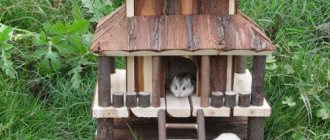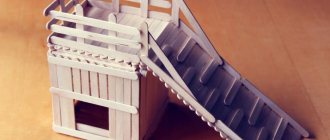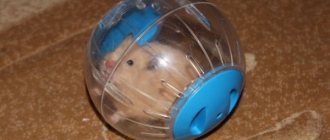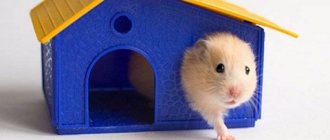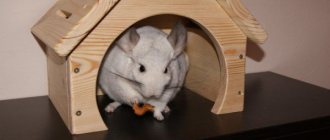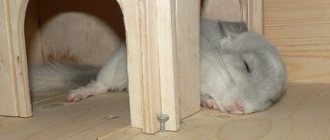- Other pets (cats, dogs) can harm decorative rabbits, so they should not be kept in the same room. In addition, it is not recommended to allow small children near small rodents.
- Rabbits can easily tolerate low temperatures, but suffer during the heat. In addition, they can get sick from excessive humidity, temperature changes and drafts.
- The cage with pets should not be placed near a heater, and direct rays of the sun should not enter the pet’s home.
It is better to allocate a separate room for rabbits - It is necessary to monitor hygiene in your pets’ home and clean their litter box in a timely manner, because due to the accumulation of a large amount of feces in the air, toxic ammonia vapors are formed, which negatively affect the well-being of rodents.
- The optimal temperature for keeping rabbits is 19-20 degrees. When this indicator increases, pets become lethargic and refuse to eat. To ease your rabbit's condition, it is recommended to wipe his ears with cool water or place a cup of ice near the cage.
In extreme heat, it is recommended to bathe the rabbit
- Rodents lead an active life in the evening and at night, so they should not be disturbed during the day.
- Hair care will vary depending on its length. Thus, long-haired pets should be regularly bathed and combed with a special comb, otherwise their fur will become tangled. While short-haired animals take care of it on their own.
Pets with long hair require careful grooming
- It is necessary to take a responsible approach to the choice of feed mixtures for these animals, because they are picky in this matter. Spoiled food or leftovers from the master's table are not suitable for pets. Without a balanced diet, they begin to eat their own feces, so fresh fruits or vegetables should always be present in the feeder.
Rules for feeding decorative rabbits
- If the pet comes into contact with other animals, then it is necessary to take care of annual vaccination, because almost all viral and infectious diseases lead to the death of rabbits.
Decorative rabbits are recommended to be vaccinated, like other domestic animals.
Preparation for construction
The design of the cage for domestic rabbits must be designed for offspring. A two-section, single-tier cage is ideal, with enough space for even a large brood. To make a rabbit house with your own hands you will need the following:
- drawing;
- 2 chipboards measuring 120 cm in length and 60 cm in width, as well as 2 chipboards measuring 60x60;
- sheet of tin the same size as the first plywood (thickness - 0.2 mm);
- bars of appropriate height;
- slats;
- iron mesh;
- nails or screws;
- hand file, metal scissors, hammer or screwdriver.
A rabbit cage can be easily built from scrap materials. But it is important to take into account the shape of the structure and its safety for furry residents.
Peculiarities
A house for a rabbit must first of all satisfy all its needs. That is, there should be enough space for both sleeping and moving around a little. In addition, for its construction it is necessary to select only environmentally friendly materials. You can buy ready-made cages for a decorative rabbit, which are available in any zoological store. In this case, the bottom is completely covered with a tray made of plastic, and the top is made of a wire frame.
When purchasing, you should pay attention to such characteristics as the height of the cage, its floor, the depth of the tray, and the presence of a door. First of all, the rabbit should calmly stand on its hind legs so as not to touch the ceiling.
But also for breeding decorative rabbits, you need to know that the floor should not be made of gratings; there must be a tray. Otherwise, he might just get hurt. In addition, it is better to choose a deeper option so that the bedding does not scatter throughout the room.
But the door must be wide so that, if necessary, you can get a small pet. In addition, it must be placed so that it is convenient to open the door. If there is very little space in the apartment, you can build a cage on two floors.
Alternative house options
Designing such small structures allows you to use your imagination and create a variety of buildings. Cell sizes are relative values and vary. If there are more individuals, then the house should be larger.
A wooden base is the most environmentally friendly choice. Possible options include lining and eco-glass.
The construction also depends on for whom the house has to be built: a rabbit, young animals or adults. If there is a female rabbit, then the house needs to be insulated, the young animals will need more freedom, so the size of the house is increased.
For the winter period, take ordinary cages and insulate them yourself using any means. The cracks are closed, part of the lattice is provided with organic insulation, and the cage is covered with something warm.
Nuances of construction
An outdoor rabbitry should be located about a meter above the ground. This makes it easier for the owner to care for it, and protects pets from snakes and other rodents.
Folding doors are considered the most convenient. Hinges hold them in place at the bottom, and a lock or latch is attached at the top. Made from wood and mesh; metal will make it unnecessarily heavier.
It is possible to install cages in several tiers. Between them there should be a layer of slate or other moisture-proof material.
Make sure there is good ventilation throughout the rabbit's home. The bottom of the female's cage should be supplemented with a tray.
Home improvement inside
Before the owner of the house moves into a new home, it is necessary to treat the cages and walls with a disinfectant. And immediately after disinfection, you cannot put a rabbit in this house, since the wood must dry completely. This takes one day.
To preserve the wood longer, you can coat it with water-based paint. Do not use oil paint. After painting, the product must dry for three days.
When using a mesh, choose a natural floor mat - bamboo or cotton. You should not choose carpet or wool, as rabbits can chew the carpet and cause problems in the digestive system. The mat prevents paws from getting stuck in the mesh and getting pododermatitis.
Bedding is used in the cages. Sawdust, soft hay and straw are chosen as bedding. For fluffy breeds, straw is chosen because it retains heat and does not get stuck in the animal's fur.
The cage must have feeding bowls and drinking bowls. The main thing here is to monitor the cleanliness of the water in the drinking bowls. It is also important that animals cannot turn them over. Stores sell bowls that are attached to the cage to prevent them from tipping over.
Beginning of work
Between the idea of building a rabbitry and its implementation stands the most important design stage. You must study the features of keeping long-eared pets and make the house as comfortable as possible for both the animals and the person who will look after them. Always remember that rabbits are living beings with their own needs.
Having decided on the breed, plan further livestock. The size of the animals, their gender and age make adjustments to the design of the rabbitry. When starting construction, it is better to provide for the possibility of further expansion.
Choose your location carefully. Try to find an area away from sources of loud noise. Give preference to the shady side and elevations: in summer the sun will not cause discomfort to the animals, and in rainy weather water will not flow into the rabbitry. Under no circumstances should it be adjacent to a compost pit.
Nothing should block access to the cells. They themselves should be as spacious and comfortable as possible.
Experience in breeding rabbits in cages
Paspay came to the floor method of keeping rabbits the hard way through trial and error. Initially, the rabbits, “ladies separately, gentlemen separately,” lived in single-tier cages, which were located around the perimeter of a small shed. With such a system, the rabbits were cramped, and the rabbit breeder was troublesome: every now and then he had to carry the rabbit on dates to one or another lady, and move the rabbits to the queen cells. In such a life, the rabbits created a terrible dirt and stench, although both the mesh floor and the tray under the cages were regularly cleaned. The most “stressful” task was constantly washing the feeders and adding food and water to them.
paspay
Anyone who has encountered this will understand.
The next stage was three-tier housing in a large barn. The rabbits were placed in cages equipped in accordance with all the rules, and, despite a number of obvious advantages, the difficulties did not diminish, the rabbits quickly multiplied, and cleaning 96 cages began to take the whole day, in addition, there was more work on distributing food and water.
paspay
During these 2 months I began to hate rabbits, because I realized that I had fallen into their slavery.
Where might your rabbit live?
You can choose an enclosure/pen or free range for your rabbit. Rabbits are the same active animals as cats. No one would think of locking a cat in a cage. You can't do anything differently with a rabbit!
Cell
A cage cannot be a “rabbit house”. Cages are forced upon us by manufacturers who in turn rely on the cruel confinement of so-called laboratory rabbits or “meat” rabbits on farms. The cage is space-saving and sterile. Neither one nor the other meets the natural needs of a rabbit. The rabbit is cramped in the cage, he has nowhere to stretch out, nowhere to hide, nowhere to stretch his paws.
Movement is one of the most important parts of your rabbit's health and longevity. Movement in the cage is limited. In a cage, a rabbit runs the risk of obesity, podmatitis, deformations of the skeleton and internal organs, as well as nervous tics (the rabbit constantly digs, gnaws the bars of the cage, licks everything in the cage, gnaws out its fur, constantly eats) from boredom.
The cage can serve exclusively as a place of shelter and toilet if there is an enclosure!
If you choose a cell, then:
It should be open 24 hours a day!
The dimensions of the cage must be at least 1 meter in length (for a rabbit weighing about 2 kg), at least 60 cm in width and in height so that the rabbit can freely stand on its hind legs. Suitable size 120 x 60 x 50
- The cage floor should not be smooth
- the cage should have a metal lattice and not be covered with organic glass
- the cage must be properly equipped, including a comfortable tray, water bowl, and resting place
- the cage must have a safe and convenient exit/entrance for the rabbit in the form of a wooden bridge
A rabbit kept in an enclosure must walk around the apartment for at least 8 hours a day.
Aviary/pen
Your rabbit should at least live in an enclosure (they are sold in pet stores) or you can separate part of the room for the rabbit, turning it into a pen. The minimum area of the enclosure for two rabbits is 4 m2 (Data provided by the Vienna University of Veterinary Medicine, as well as a number of German and Swiss rabbit protection associations in consultation with veterinarians).
A common misconception about kennels is that they take up a lot of space. In fact, the enclosure can be placed in a place convenient for you and given almost any shape.
An aviary is a much more beneficial type of housing for the health and development of a rabbit, since the installation in an aviary or pen can be varied and multi-story. You can install cardboard houses and tunnels in the enclosure so that the rabbits can play and move, dig and hide - and therefore develop and remain healthy. Also, an enclosure allows you to protect your apartment from the teeth of young rabbits who do not yet fully understand the rules of your home.
In the enclosure you should also install a tray, drinking bowl or water bowl, possibly a hay barn. Also make sure that the floor is non-slip and not too hard. You can put a soft rug on part of the floor.
Keeping in an enclosure is an excellent stage before keeping a rabbit in the wild or if there are small children in the family.
An example of an enclosure for rabbits (two enclosures combined into one large one):
Types of cages for rabbits
Cages for rabbits can be roughly classified according to the following criteria:
- by type of pet (for large or small breeds, general or single, cages for mating, queen cells, cages for young animals); — by method of operation (stationary and portable, outdoor, indoor, universal); - by the number of tiers; - by type of material used (wooden, chipboard/fibreboard/plywood, metal, mesh, plastic, combined).
Industrial cages for rabbit farms are significantly different from decorated “houses” for decorative pets. The latter are usually kept in boxes consisting of a deep plastic tray and mesh. The doors can be plastic or plexiglass; inside there is space for bedding, a feeder, and sometimes an additional closed compartment so that the animal can hide.
Individuals bred for economic purposes are often housed in multi-story structures with a large number of separate enclosures. Such a cage can either be purchased ready-made or built independently using available means.
Selection of design type
Check out the photos of finished rabbit hutches and see how they are structured.
Considering the number of pets, calculate how many cages you will need and how best to install them. In addition to single and two-section, rabbitry can be:
- Single-tier;
- Multi-tiered;
- With an aviary;
- In the form of an extension to the main room.
Having a clear plan, start building a drawing of the rabbitry. Take into account every little detail: size, location of doors, feeders and drinkers, taking into account the needs of each pet.
House for a rabbit, how best to place it indoors
There are many options for housing your rabbit indoors, kennels, rabbit houses, cages and others. We will discuss each of them below.
Free living in an apartment
If you decide to provide the entire apartment for your decorative rabbit to live in, then you need to put a toilet, a box with hay, and a plastic mat on which you need to place a bowl of food and water in one of the rooms. They will come and eat, drink or go to the toilet when they need to. If you are going to leave them alone in the house, then provide them with cardboard boxes for entertainment.
Aviary
A great option is to install an enclosure in the corner of the room for your rabbit. An enclosure can be purchased at many pet stores or you can make it yourself.
Enclosures are large enough to accommodate everything a rabbit needs and allow them to move freely.
If you are concerned about your flooring or carpet, you can place a plastic mat, piece of linoleum, or old carpet in the enclosure. (Make sure your rabbit does not eat these materials because it can cause constipation. If the edges of the mat are placed outside the enclosure, the animal will not be able to chew on it.) Enclosures usually do not have a roof, so make sure you buy one of this size so your rabbit can jump over it. Usually this height is about 80-100 cm.
Enclosures are useful if you intend to eventually keep a free-ranging animal in your home. Limiting your rabbit's space at the beginning will allow him/her to get used to the layout of the litter box and feeders. By gradually increasing the space, your rabbit will not be overwhelmed by the large area. This helps prevent accidents and reduce stress.
DIY cage
If you have limited space, then you can build a multi-story cage for your pet. You can use wood, metal, and other materials to build a multi-story cage. (See photo gallery of modern and stylish DIY cage ideas) One thing to note is that you should not build a rabbit fencing out of plastic chicken mesh because rabbits may chew on it and accidentally swallow it. Also, if you decide to use metal mesh, the mesh should be large enough so that the rabbit cannot stick its head between the bars. Otherwise, your rabbit may become injured or suffocate himself. (Step-by-step instructions on how to build your own rabbit house.)
Rabbit cages
Of all the housing options, rabbit hutches provide the least amount of space for your rabbit. However, if you decide to house your rabbit in a large cage, you must ensure that the rabbit has plenty of time outside the cage - at least a few hours a day. Options for cages are varied, but you need to know a few rules.
The cages must be large enough to accommodate the rabbit. The bigger, the better! There should be room for your rabbit to move around and lie down, as well as space for food, water, litter box, and toys. Never use glass aquariums as they are not large enough and do not have proper air circulation. It's also best to have a cage with a door on the side so your rabbit can come and go on his own.
Some owners prefer cages with wire bottoms because they can place bedding underneath. This is a good option, but in order for the rabbit to stand/lay down, you will need to place a piece of wood or cardboard on top. When standing on a grid, a decorative rabbit may experience discomfort.
There are many different housing options that you can consider for your rabbit. Rabbits need a place where they feel safe, as well as a place to exercise. The best option will depend on your living conditions. But remember, rabbits are very social creatures, so choose a place in your home that won't make your rabbit feel lonely and abandoned.
Collection rules
In order for the animals to be as comfortable as possible in the manufactured house, it is necessary to follow certain rules during construction. It is advisable not to violate them:
- The protruding parts must be covered with tin.
- It is advisable to use slate for the roof.
- Under no circumstances should you use varnish or antiseptic for impregnation; rabbits will not like the smell.
- An extremely durable wooden beam is used as a frame.
- The back walls can be made of plywood.
When the drawing is completed and the materials are prepared, you can proceed to the actual construction. First of all, the frame is assembled, and then the mesh floor is laid.
If outdoor maintenance is planned, then the floor is insulated and a removable tray is installed underneath it. This is necessary for cleaning. Next, you can install the back wall, which is made of plywood. It is worth noting that it must be lower than the front one. The side walls can also be made from a sheet of plywood.
If the cage is planned to be double, then a hay barn is installed in the middle. The last wall is made of mesh, with a door. If the cage will always be outdoors, then it is necessary to properly insulate the sleeping compartment. It is advisable to make the roof at an angle and then cover it with slate. This is necessary to prevent water from accumulating on the surface after rain.
The contents of the cages may differ; it is chosen depending on what kind of rabbits will live there. For small rabbits, you need to install special queen cells, as well as nesting compartments. If there is group keeping, then a well-heated nesting room should also be arranged.
Before starting assembly, you need to decide on the place where the structure will stand. The place should be comfortable and protected from draft winds. In no case should you place a house for a rabbit on the south side, since there the animal will suffer greatly from the extreme heat. If the house will stand on the street all year, then the floor must be made in such a way that it slides out like a pallet, with a lathing of slats placed on top of it.
If you take into account all these nuances, then making a cage for a rabbit will not be difficult.
Manufacturing stages
To make a rabbit house, you need to follow this plan:
1. A rectangular piece is cut out of plywood, 70 cm long and 60 cm wide. It is connected to 4 beams 45 cm long. To do this, holes are made in them through which self-tapping screws are screwed.
2.A rectangle of the same size as the previous one is again cut out of plywood. This will be the base of the top floor. A square hole is made in its lower left part through which the rabbit will climb up. Its size depends on the size of the pet.
3.The base of the cage (part No. 1) is connected to the partition (part No. 2) using self-tapping screws.
4. On medium-thick plywood, mark 2 side walls, which have the following parameters: 60x92 cm. Then they are cut out with a saw.
5. The sides are fixed to the frame so that the structure is level.
6. 4 racks are made from the beams, which are attached to the base of the second tier with self-tapping screws. Then the sides are cut out of thick plywood and fixed to the frame. After connecting all the walls and ceiling, the structure is almost ready.
7. A piece measuring 1.2x6 cm is cut out of the board. This will be a threshold that will not allow food and bedding to spill out. It is fixed to the vertical supports below using self-tapping screws.
8.The frame for the door is made of boards. You need to cut out parts that fit the size of the cage. Wooden elements are connected using a stapler. If desired, the structure can be strengthened with steel corners.
9.The door frame is covered with a mesh, which is fixed with a stapler. Then the door is attached to the house on its hinges and a latch is installed.
10. The staircase is made of thin plywood. To do this, cut out a part whose height corresponds to the distance between the floor of the first floor and the ceiling of the second. It is installed at an angle so that the rabbit can climb up. The top of the stairs is covered with pieces of rubber or ice cream sticks. This is necessary so that the animal does not slip while climbing.
11.Furniture legs are attached to the bottom of the house. They must be stable.
Important! After the owner finishes building a house for rabbits, he must treat all surfaces with an antiseptic composition. This is a special water-repellent solution that protects wood from rotting. After applying it, the structure must dry under the sun.
If the structure will be located on the street, then you need to insulate the walls and make a high-quality roof. A pitched roof is suitable for weather protection. It is enough to stretch the roofing material onto the timber sheathing. The roofing material is secured using mounting strips, nails or self-tapping screws. Instead of roofing felt, you can use slate, sheets of metal or tiles.
For additional protection from moisture, a waterproofing film is laid under the roofing material. Then the house will be warmer and more comfortable.
Materials
The amount of material is calculated based on the number of buildings and drawing calculations. For the design you need:
- Beams, slats, planed boards, plywood;
- Mesh for walls, partitions, floors;
- For the roof - roofing felt, tin, slate;
- Latches, door hinges, portable handles;
- Self-tapping screws, nails.
Standard carpentry tools are suitable. If more complex work is involved, involving welding and cutting, then it is better to seek help from knowledgeable people.
- Types, applications and characteristics of paving slabs
- Is a land plot required to be inspected before purchasing it?
- What models of corner sofas exist: how to quickly navigate through the variety of models and colors
What should a rabbit's home be like?
For pets to be healthy and feel good, they need to exercise a lot and live in conditions as close to natural as possible. Accordingly, the place to live should be quite spacious. This fact is not taken into account in mass production of cages, so it is best to design a house for a rabbit with your own hands.
If this is a house for a decorative rabbit that lives in an apartment, then it is best that the animal has the opportunity to move freely around the house and uses the cage only for sleeping. In this case, the pet will be able to gain a certain muscle mass and will develop normally. Decorative rabbits that are constantly kept in cages get sick much more often.
The arrangement of houses for rabbits should be thought out to the smallest detail. In a cage that is too small, animals gain a lot of excess weight, become lethargic, and are often stressed. Today, making houses for rabbits with your own hands is not a problem. On the Internet you can find just a huge number of all kinds of photos that show detailed drawings with correct calculations. You just need to choose a simple design option and get to work.
Requirements for a rabbit house:
- the container should be so free that the eared cat can stand on its hind legs in it: the dimensions are calculated based on the dimensions of their pets;
- an enclosure must be attached to the cage, into which the eared animal must have free access at any time;
- the internal arrangement of the cage consists of a drinking bowl, a feeding trough and a toilet;
- in the corner of the structure it is necessary to arrange a place for sleeping in which the animal will feel safe.
Containers for females
The rabbit's house, or queen cell, will be slightly different from a regular rabbitry. Females and their offspring must be kept separately.
Some people mistakenly believe that females do not need separate apartments with special furnishings to reproduce offspring. However, in an open cage, the rabbit will be constantly exposed to stress due to sharp sounds and smells and will not be able to fully perform maternal duties. In addition, babies are born completely unadapted to life: blind, deaf and naked. In the first few days, baby rabbits need especially careful heating and a stable supply of mother's milk, which may never appear if the animal is constantly under stress.
According to the drawings, a house for a rabbit is no different from the simplest single cage. To keep female rabbits with their offspring in winter, the containers are insulated and insulated. Foam sheets or mineral wool are used as insulation, and the top is sheathed with an additional layer of wood.
House for a rabbit
The internal arrangement of the box for the female rabbit will differ in the presence of a queen cell in it. It is another small container. It is very important that its dimensions are not too large, otherwise the female, deciding that this is another cage, will defecate there. Too small an area of the queen cell will not allow the female to fully cover the nest with wool and equip it for the birth of the babies. The sizes are selected in accordance with the characteristics of the rabbit breeds.
It is important to remember that first-born females may forget to line the nest with fur, becoming confused. To do this, you need to make the cage in such a way that you can independently put hay and cotton wool into the nest. To prevent the wooden covering on the floor from rotting by reacting with the waste products of the baby rabbits, it must be covered with galvanized sheets. But in this case, you will need to make a flooring of straw of at least 20 cm, otherwise in cold weather the droppings will simply freeze on the cold floor.
You should not build a rabbitry for females from freshly cut trees with a pungent odor: the woody aroma can scare away the female, and she will not use the nest for its intended purpose, in the worst case, she may even abandon rabbits altogether. If you are going to breed rabbits for sale, then this design is an ideal option for the farm. It will allow you to reproduce year-round.
House for rabbits out of a box
Of course, a home for pets made from a cardboard box can hardly be called durable. However, this is a great option if you need a temporary home. In addition, some residents prefer to constantly let the rabbit walk around the apartment, and the pet uses the cage only as a sleeping place and toilet, so it does not necessarily spend money on an expensive structure.
It is necessary to select a box according to the size of the rabbit. If the animal is large, then you can connect two boxes
During the work we will need the following materials and devices:
- cardboard boxes - 2 pieces (35 centimeters high and 45 centimeters long);
- compass;
- stationery knife or scissors;
- adhesive tape;
- simple pencil.
Table No. 1. Instructions for making a rabbit house from a box
| Step, no. | Description | Photo |
| Step 1 | You need to take one of the boxes, turn it over and draw a circle on the side that will serve as the entrance to another box. In this case, it is not necessary to make a threshold, but you can draw a semicircle and then cut it off at the bottom. The same holes should be drawn in the other sidewalls. Only the back part will remain without an opening. | |
| Step 2 | Now you should carefully cut out these circles along the contour. Therefore, for such purposes it is better to use a stationery knife, but if you don’t have one, then scissors will do. | |
| Step 3 | After all the holes are ready, you need to turn the box over, then fix its edges and wrap it with a thick layer of tape. This will result in a durable structure. The same manipulations should be done with another box. | |
| Step 4 | Now, using tape, you need to connect the two boxes together so that their internal openings coincide. The door of this home will not close. If desired, you can throw a light, breathable fabric over such a house to curtain the passage while the rabbit sleeps. |
As a result of such manipulations, it was possible to obtain a spacious house for one rabbit with two central openings and one side one.
My own master
If you decide to make your home yourself, you get a lot of advantages. Firstly, you can realize all your wishes and plans. You yourself determine the shape, color, number of tiers. Secondly, you will create an ideal habitat for your pet if you take into account all its needs and character traits.
By equipping the cage according to all the rules, you will create an ideal habitat for your little friend. And, of course, you will have a unique house, the only one in the world. Agree, it’s nice to know that your rabbit is special, and this is your merit.
What do we need?
Competent drawings and high-quality materials are the main components of the process. Therefore, first of all, you will need a pencil and a notebook. Before you start designing, look at photos of cells on the Internet. This way you will decide on the direction, get inspired and get a lot of ideas. In the photo below we offer only one of the options for possible home planning.
To build the cage, metal mesh and sheets of plywood and chipboard are most often used. These materials are inexpensive and easy to use. Wooden slats are useful for the outer framing of the house. You can also make a staircase or bridge from them.
It is advisable to cover the floor with a smooth material, without cracks or gratings. The material must also be resistant to moisture. A sheet of tin or plastic is best. From construction tools we will need:
Various fittings may be needed to attach doors and feeders. The door can be made hinged. Or you can build sliding doors. For security, you can close the entrance with a simple lock: a hook or a latch. Consider keeping the entrance open.
If it is possible to keep your animal outside during the warm season, take care of a good shady place. In this case, you need to make a solid roof for the cage or provide a canopy under which the animal can hide from the wind and sunlight.
Let's get started
To make a cage yourself, you need to first sketch out the drawings. In them you experiment by arranging a feeder, shelter and tray. Determine what height and area will be in the rabbit house, how many floors. Once the plan has been drawn up and the materials have been prepared, we begin construction.
- First you need to make the floor. Take a sheet of chipboard and cut out a rectangle or square of the desired size. The top layer of tin or plastic will be the same size. It is needed to ensure that the bottom of the cage does not become wet or deformed.
- For more convenient removal of garbage and waste, you can make a pull-out tray with your own hands or build part of the bottom from a mesh. Then cleaning the cage will take much less time.
- Next, we proceed to making the cage frame. It is most often made from beams, slats or thick iron rods. Which material to choose – decide for yourself what is more convenient and practical for you. It is better to protect the bottom with sides so that hay and sawdust do not spill out.
- The next stage is covering the walls with mesh or plywood. Securely secure the covering with self-tapping screws so that the rabbit house is reliable and stable. If you have planned a two-story structure, you need to again cut out a floorboard of the required area from chipboard and attach it to the walls of the cage and the frame. Make a staircase from wooden slats to the second tier. It should be wide enough so that the animal does not fall off it.
- Then it’s a matter of little things: attach a roof made of mesh or plywood, build in doors and arrange a shelter, drinking bowl, and feeding trough. You can make a removable roof, then it will be more convenient to remove the cage. And build a bridge to the entrance, then it will be easier for the inhabitant to move around.
If during the construction process your imagination runs wild, you can beautifully decorate the facade of the hole by decorating the walls and roof. And also make various labyrinths and holes for your pet so that his leisure time is useful and varied.
{SOURCE}
Cell sizes
It is necessary to correctly determine the dimensions before you start making a cage for rabbits with your own hands; the drawing should be based on them. One cage is not enough if you plan to breed rabbits. It is necessary to build three or four internal sections at once. If you place all the animals in one area, then it will be very uncomfortable for them to live together, and various problems will arise during breeding.
Approximate dimensions of a standard cage:
- Length - 140 cm.
- Width - 80 cm.
- Height - 50 cm.
If the rabbits are still very young, then 90 cm is enough length, but it is better to leave the other parameters the same. One adult rabbit requires 0.7 square meters. m of free space. For a young person, 0.2 square meters is enough. m, but no less!
There are several types of cages for rabbits:
- For young animals.
- For adults.
- For a female rabbit with offspring.
- For large breeds (“giants”).
You can assemble all these rabbit cages with your own hands.
Room for young animals
Growing rabbits must be separated from their mother and kept in groups of 10-20 individuals.
For them, you will need to assemble a cage with a total area of 30 by 100 cm, a height of 50 or 60 cm. The floor must be made of thin wooden slats, previously covered on the side with a metal mesh. The cells must be small so that rabbits cannot get out through them. You can also make a mesh floor, but you will need to provide a separate warm room where the animals can warm up.
In winter, the entire structure should be well insulated with straw and hay. Many farmers simply do not want to provide separate housing for the younger generation of rabbits, so they place them in cages that are intended for adult varieties. In this case, it is necessary to calculate how many animals can be placed in one cage so that they feel comfortable. If the house is too small, an additional one will be required.
For adults
For an adult rabbit, the cage depth should be 70 cm, height 60 cm, and length at least 1 meter.
Here it is necessary to use a block design, and each block is divided into two sections by a grid. During the mating period, the grate should be removed so that the two sections become one space. You can make a three- or two-tier cage. This design will be somewhat more complicated, but this way you can save space on your site. It is necessary to prepare a separate place in the cage for sleeping, walking and eating. For this purpose, structures at a distance of 15 cm from the floor are separated by a plywood partition, which has an opening of 20 by 20 cm. The sleeping compartment is equipped with a wooden door, and the place for eating and walking is equipped with a mesh door.
House for a rabbit
It is recommended to build a separate house for a female rabbit with her offspring only for the winter period.
When setting up, remember that the female will be nervous in a cage fenced with a mesh, and this will have a bad effect on the offspring. The house must be closed so that the mother is confident in the protection of her offspring, but a house made of mesh will not give her such confidence. Only the front wall can be made from mesh. The cage needs to be well insulated. The frame is made from good timber, the back and side walls are made of plywood. The cage must be immediately divided into several sections: a large one where the rabbits will walk, and a small one for the nest. Doors must be made for each compartment. The walls and floor must be made double, according to the sandwich principle. Straw and foam plastic are laid between them for insulation. The roofs are covered with any slate.
Aviaries for large breeds
Giant rabbits are very large varieties, so their home must be much larger than for ordinary rabbits. Adults grow up to 60 cm in length and can reach a weight of 8 kg.
Minimum house sizes for one rabbit:
- Height - 65 cm.
- Length - one and a half meters.
- Width - 75 cm.
These parameters can even be increased to make the rabbit feel comfortable inside. For a young rabbit, it is necessary to build a group cage with a height of 50 cm and an area of 1.2 square meters. m. The weight of the animal will be quite large and the floor needs to be well strengthened. It is also best to use galvanized mesh, but thicker. To prevent the floor from falling through, the sheathing underneath must be made of bars, which are located at a distance of several centimeters from each other.
Necessary materials
First of all, you should decide on the size of future cells. The most common option is a double design, which has two separate sections.
There are other types of housing:
- single-section;
- group (for young animals);
- with three sections;
- with mother liquor.
The photo shows standard single-section cages for adult animals.
Creating any structure for keeping rabbits involves step-by-step production of the frame, floor, walls, ceiling and door, followed by assembly. In most cases, wood and metal mesh are used in construction. Therefore, for work you will need the following tools and materials:
| Tools | Materials |
|
|
Before you start designing, you need to acquire all the necessary tools
The wood should first be sanded and thoroughly sanded, and the ends of the mesh should be securely fastened. All sharp edges must be removed, otherwise the animal may be injured. It makes sense to cover wooden surfaces inside the home with tin to make the enclosure more durable, since rabbits love to gnaw on everything that catches their eye. Thick wooden beams are usually used for the main frame, and the walls and ceiling are made of plywood sheets and mesh. Note that if the rabbits’ home is located outdoors, then the length of the legs of the frame should not be less than 80 cm. For cages placed indoors, 30-centimeter legs will be enough.
If the enclosure will be located in the open air, then it is important to pay special attention to the construction of the roof of the home. Direct sunlight, precipitation and drafts negatively affect the well-being and health of animals. It is not recommended to make a roof out of metal - it gets very hot in the sun, which can lead to heatstroke in a rabbit
It is better to cover the top of the structure with slate
It is not recommended to make a roof out of metal - it gets very hot in the sun, which can lead to heatstroke in a rabbit. It is better to cover the top of the structure with slate.
House for a rabbit in an apartment
The structure in the apartment should be built from wood. A house must be beautiful to make it a pleasure to live in.
The cage should not be placed in places with drafts; location next to a radiator in winter will create excessive stuffiness
DIY rabbit house - compact design. Often apartments have little space, so a two-tier wooden house is a more popular option. Material costs will remain almost unchanged, but the drawings will have to be redrawn. A staircase to the second floor, compartments and a floor will be required.
Roofs are not installed in such a house due to the stable temperature in the apartment (18-20°). There are structures without pallets.
Insulation
Rabbits feel comfortable at a temperature of 10-20º. Therefore, for the winter you need to either move the house standing in the fresh air to a warm place, or insulate the existing home.
Cover the door with plywood. It’s even better if you glaze it - this option will allow the animals to receive more sunlight. Add a layer of hay to the wooden flooring. The walls can be insulated with ordinary polystyrene foam.
An alternative approach is to build a special shed with heating. Be sure to make a foundation, and the room itself can be wooden or brick. The main thing is that there are no drafts anywhere. The doors should also fit tightly in their frames and protect the shed from the cold. On the south side, arrange a walking area.
For a summer residence, the second option for organizing a rabbitry is more convenient.
House care
Rabbits are quite capricious in their maintenance and are very sensitive to cleanliness in their home. Therefore, the breeder must:
- Clean the tray from manure. Ammonia fumes have a negative impact on animal health.
- Remove remaining grains, vegetables and hay from the bottom of the house daily. Wash the rug or replace it with a new one.
- Change the bedding in your home. This must be done every day, as otherwise the risk of animal illness increases due to high humidity.
- Wash the feeders thoroughly before feeding again, as rabbits are characterized by increased sensitivity of the gastrointestinal tract. Disinfection will be especially effective if you boil the water bowl, feeder and hay barn.
- Change water in drinking bowls regularly. This should be done at least 3 times a day.
- Use a vinegar solution to clean up dried urine.
- Ventilate the rabbitry regularly.
- Wash and dry toys from a decorative rabbit.
- Conduct a general cleaning of the rabbitry with complete disinfection every six months. Synthetic solutions cannot be used for this.
You can make a house for rabbits at home without the help of specialists. The most difficult part in this process is calculating from drawings and drawing sketches. A properly equipped home will be the key to good animal immunity. It is important to design the house so that the owner can freely carry out all the necessary cleaning and disinfection procedures in it.
Feeders and drinkers
Wood is usually used to make them. Plastic can be toxic, so it is safer to use classic material.
Place feeders along the long side of the rabbitry. Be careful with the size so that there is no crowding during feeding. Their height is such that animals cannot steal food.
The dimensions of the feeder in the compartment of the female with the rabbits are at least 40x4x4 cm. The presence of retractable compartments will be relevant.
Between the sections of the rabbit house, provide gaps through which it is convenient to feed hay and feed. Through a nursery with an external door, you can offer roughage to the animals.
Attach the drinking bowl to the side wall. A “cheap and cheerful” but effective option is a bowl and a water bottle inverted into it. A small hole is made in the lid. This way, as you drink from the bowl, the drinking bowl will be replenished from the bottle.
Making a rabbitry with your own hands is not difficult. Look at the photo - these could be real cozy houses. If animals feel good without experiencing discomfort, they will grow and reproduce faster, which is what any breeder strives for.
Sources:
https://pets2.me/bok/1308-kak-sdelat-domik-dlya-krolika-svoimi-rukami.html https://fermoved.ru/kroliki/domiki.html https://landshaftdizajn.ru/krolchatnik- svoimi-rukami/

